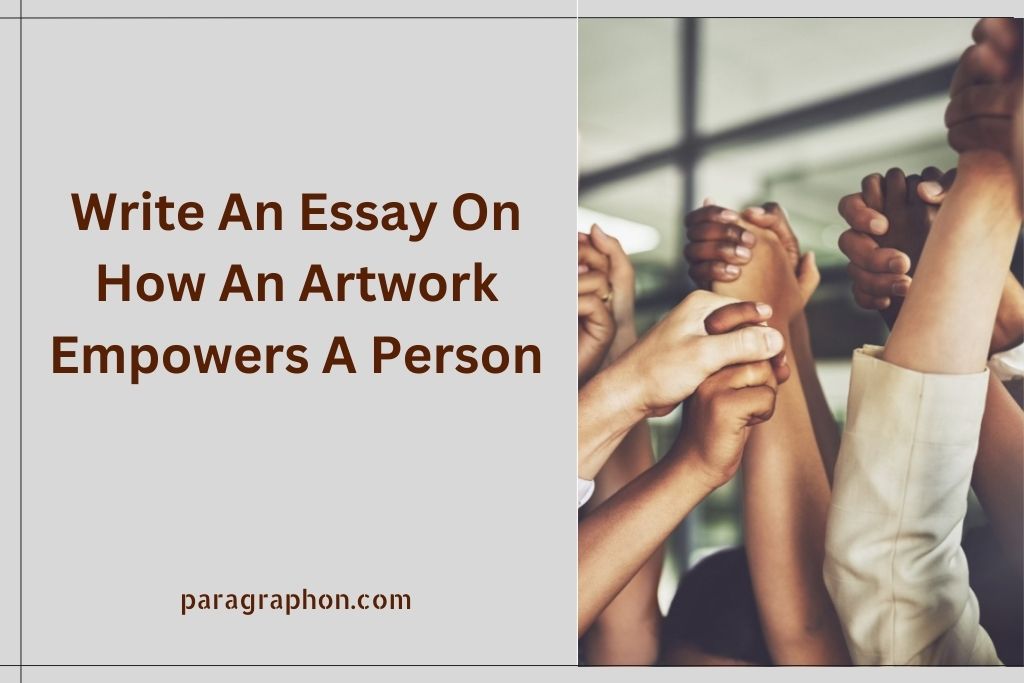Art possesses an extraordinary capacity to reach the very core of the human spirit, going beyond language and cultural boundaries. It goes further than just looking beautiful; art has this incredible ability to profoundly empower individuals, aiding in self-discovery, resilience, and personal growth. Here we will write an essay on how an artwork empowers a person. Throughout this essay, we’ll delve into the ways in which artwork empowers people, examining the psychological, emotional, and social aspects of this transformative journey. Together, we’ll uncover how art, in its simplicity and beauty, becomes a guiding force in unlocking the potential within each of us, connecting us to ourselves and the world around us in meaningful ways.
1. The Emotional Connection
One of the fundamental ways in which artwork empowers individuals is through the establishment of a deep emotional connection. Art has the capacity to evoke a wide spectrum of emotions, from joy and wonder to introspection and melancholy. When a person encounters a piece of art that resonates with their emotions, it serves as a mirror reflecting their innermost feelings and experiences.
Consider, for example, a painting that captures the tumultuous beauty of a stormy sea. The crashing waves and turbulent sky might resonate with someone going through a challenging period in their life. The artwork becomes a vessel for them to externalize and confront their emotions, offering a cathartic release that can be profoundly empowering.
2. Self-Expression and Identity
Art provides a means for individuals to express themselves in ways that are frequently beyond the capabilities of words.Whether through painting, sculpture, dance, or any other form, the act of creating art becomes a means of self-expression and a tool for exploring one’s identity. The journey of self-discovery holds immense power, offering individuals the opportunity to develop a profound understanding of their identity and core values, ultimately fostering empowerment.
For instance, a person grappling with their identity might find solace in creating a collage that represents different facets of their personality. As they arrange images and symbols on a canvas, they are not only creating art but also unraveling the layers of their own identity. This act of self-expression fosters a sense of empowerment as it allows individuals to take ownership of their narrative and shape their own story.
3. Healing and Resilience
Art has been recognized as a powerful therapeutic tool, aiding in the process of healing and promoting resilience in the face of adversity. Whether coping with trauma, loss, or stress, engaging with art can provide a refuge for individuals to navigate their emotions and find inner strength.
Art therapy, for example, has been widely used to help individuals overcome mental health challenges. The act of creating art can serve as a form of meditation, offering a respite from the demands of everyday life. Moreover, the tangible outcome of the artistic process becomes a testament to one’s ability to transform pain into something beautiful, reinforcing a sense of resilience and empowerment.
4. Perspective and Empathy
Art has the unique ability to broaden our perspectives and cultivate empathy. When individuals engage with artworks that depict diverse experiences, cultures, and emotions, it opens a window into worlds they may not have encountered otherwise. This exposure fosters a sense of connection and understanding, breaking down barriers and promoting a more inclusive worldview.
For instance, a photograph capturing the resilience of a community in the face of adversity can inspire viewers to reflect on their own challenges and strengths. The ability of art to communicate universal themes allows individuals to connect with the experiences of others, promoting empathy and a sense of shared humanity. This expanded perspective empowers individuals to navigate the complexities of the human experience with a greater sense of compassion and understanding.
5. Empowerment Through Creation
The act of creating art itself is a transformative and empowering process. Regardless of skill level, the act of bringing something into existence, whether it’s a doodle, a poem, or a sculpture, is an assertion of one’s agency and creativity. This act of creation can be particularly empowering in a world that often demands conformity and adherence to predefined norms.
Consider a person who, despite lacking formal training in art, decides to pick up a paintbrush and create a canvas that expresses their unique vision. The act of creation becomes a declaration of individuality and a rejection of societal expectations. This sense of empowerment through creation extends beyond the artistic realm, influencing how individuals approach challenges and problem-solving in their daily lives.
6. Social Empowerment and Activism
Art has historically played a pivotal role in social and political movements, serving as a powerful tool for advocacy and change. Artistic expressions, whether visual, performing, or literary, have the ability to challenge the status quo, raise awareness, and inspire collective action. In this way, art becomes a vehicle for social empowerment.
Consider the impact of street art that addresses social justice issues. Murals and graffiti can transform public spaces into platforms for dialogue and activism. Individuals who engage with such artworks may find themselves inspired to join movements, speak out against injustice, and contribute to positive social change. This connection between art and activism empowers individuals to become agents of change in their communities and beyond.
Conclusion
In conclusion, the transformative power of art is a multifaceted journey that encompasses emotional connection, self-expression, healing, perspective, and social empowerment. Whether as creators or observers, individuals can harness the profound impact of art to navigate the complexities of life, discover their true selves, and contribute to positive change in the world. As we continue to engage with art in its various forms, let us recognize and celebrate its capacity to empower the human spirit, fostering a deeper connection to ourselves and the world around us.
Frequently Asked Questions
How can art help individuals cope with difficult emotions?
Art provides a cathartic release by allowing individuals to externalize and confront their emotions, offering a transformative and empowering experience.
Can anyone experience the empowering effects of art, regardless of artistic skill?
Absolutely. The act of creating art, irrespective of skill level, is an assertion of individuality and creativity, fostering empowerment in a world that often demands conformity.
How does art contribute to social empowerment and activism?
Art serves as a powerful tool for advocacy and change, inspiring individuals to engage in social movements, speak out against injustice, and contribute to positive societal transformation.

